May/June 2009
Mantegna Siempre la Calma
Argentina, Buenos Aires and a little Uruguay
We signed off as we left Salta in NW Argentina. From there we moved a bit further east and then headed south toward Córdoba, looking for a chiropractor for Kathy. We stopped in Jesús Maria, about 25 miles north of Córdoba. We had figured it might be easier to negotiate finding a chiropractor in a small-ish town rather than a huge city. Turned out to be easy. We went to the local hospital, explained the problem (me duela aquí, and point to my knee – rodilla), and the nurse knew exactly who to send us to. How cool was that!
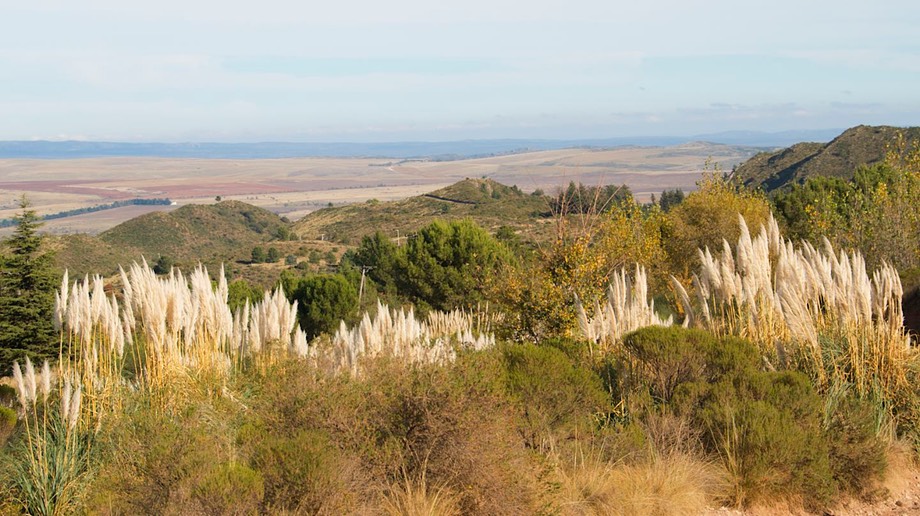
Driving between Salta and Jesús Maria, we moved away from the beautiful redrock countryside we had been enjoying so much, and out into the “wet” pampas further south and east. The landscape became more open, with estancias and goats and pigs and cattle. The “wet” came from occasional wetlands, and we were definitely seeing more birds. Huge fields of corn took over; we even saw the remains of cotton that had been harvested. There were huge kilns near the road, making charcoal; smelled like they were smoking pork at the same time. This was really different from the area close to the Andes. As we moved further south the small towns began to appear more prosperous; we spent the night in Sumampa, along the square, which was being rebuilt; there was lots of other new construction in town as well. Seemed to us like the town was preparing for expansion; good for them!
When we got to Jesús Maria, we stayed in the area for over a week. Between appointments with the chiropraxia, we toured the area in short spurts. Our Argentine buddy, Mabelle, had waxed very enthusiastic about the area to the west and north of Córdoba, and we really wanted to see for ourselves. It was quite lovely; fall color was in full swing, and it was still warm during the day. The light had that quality it gets just before everything turns to grey.
We had a really good time. We took back roads through the hills and stopped in little towns. This area is a bit touristy in places, so we avoided the towns that seemed just too-too; yoga spas were a good indication we needed to move on. But there were many charming villages, the pyracantha bushes were full of berries (both red and orange-yellow), and the hillsides were lovely. We spent two days sitting atop a ridge where we could see all around us; no one came by, we sat in the sunshine; wow!
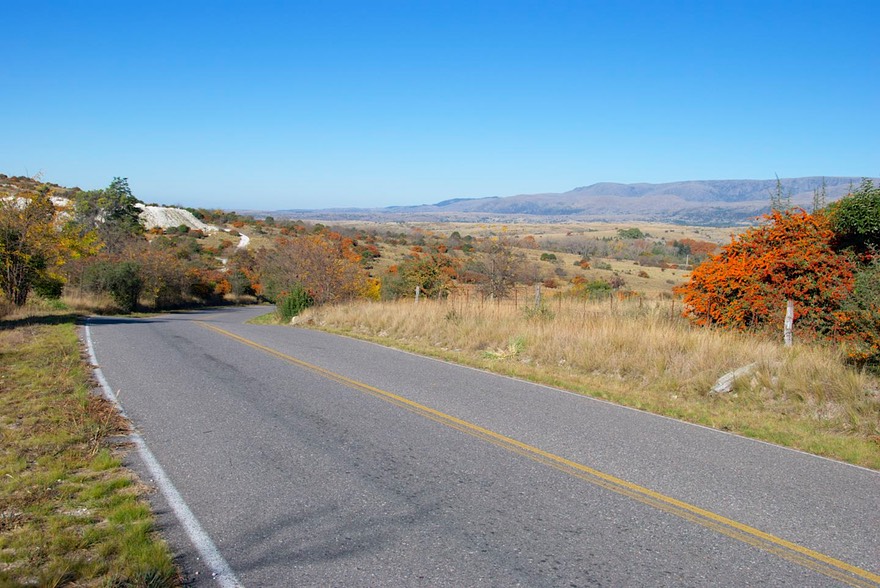
This was a holiday weekend, and on Sunday we trucked down Rt. 38, a tad too close to Córdoba; it was kinda like being on the Pacific Coast Highway on a Sunday. Too many folks. But still pretty. We wandered up Rt. 34 onto the Pampa de Achala, where you could hike to see condors (no, no hiking this time; Kathy can hardly move) and spent another night out in the middle of nowhere on this high and craggy plateau. It being a holiday, the motorbikes were out in force, and Rick was kept entertained by spotting several different very old bikes, some in excellent condition, being taken out for a spin.
In addition to wandering the countryside, we also spent a few days just hanging out in Jesús Maria. We found ourselves liking this town more and more. It had plenty of services available and was quite modern, being so close to Córdoba. But it also had a good sense of itself and its own character. We noticed the police were really enforcing the traffic laws; people were actually stopping where they should and obeying the speed limits. A new traffic light had just been installed, and there were police on duty nearby giving people warning whistles when they whizzed through, unaware. We were given a warning when we stopped for a couple of seconds in a taxi parking area. Awesome! We are commenting on this because we have spent soooo much time in Argentina, home of the arrogant driver who ignores any and all signage. But not in Jesús Maria!
We finally left Jesús Maria and trucked on down into Córdoba. We were desperate for propane, and knew we could find it there. And for once the experience was, like, superb momma! We found the plant, the truck would be there in a couple of hours, he arrived, said “no trouble, man” and filled us and we were gone. Slick as a whistle. Damn!
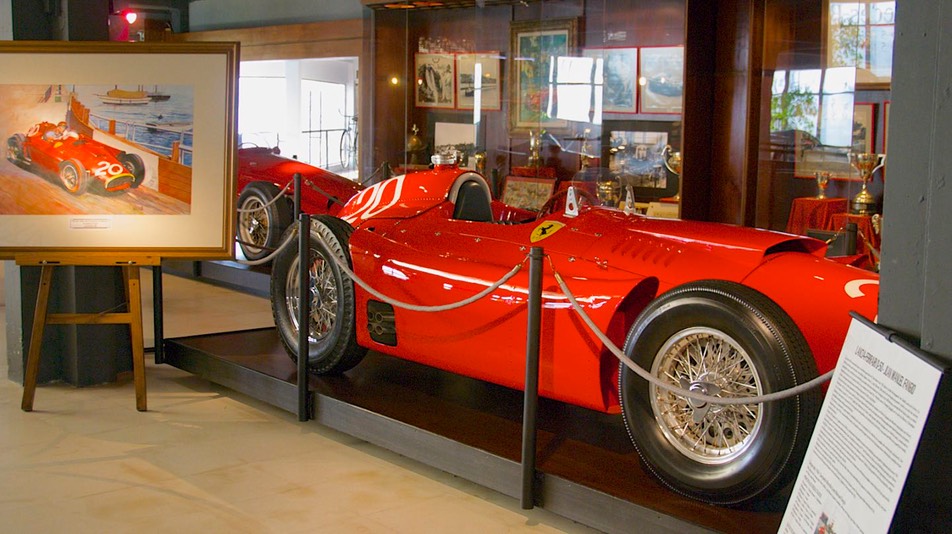
Being all fixed up, where were we off to? Hey dude, the Fangio Museum, of course; it’s in Balcarce, a couple hundred miles south of Buenos Aires, near the Atlantic Coast. Who the hell is Fangio? Shame on you. In the 1950’s, Juan Manuel Fangio was five-time world champion of what is now referred to as Formula I racing. He was the best driver of his era, winning the five championships with four different manufacturers over the course of seven years of competition, including the last four consecutively. He would probably have won even more but for injuries suffered in the only serious crash of his career, in 1952. Anyway, you can read all about him online if you like. Needless to say, he was born in Balcarce. The museum was beautifully done and included three of his championship cars from Mercedes-Benz, Ferrari, and Maserati. Rick toured the museum alone and enjoyed it immensely. Go over to Motor-Museums.com to see lots of great photos of this fine museum.
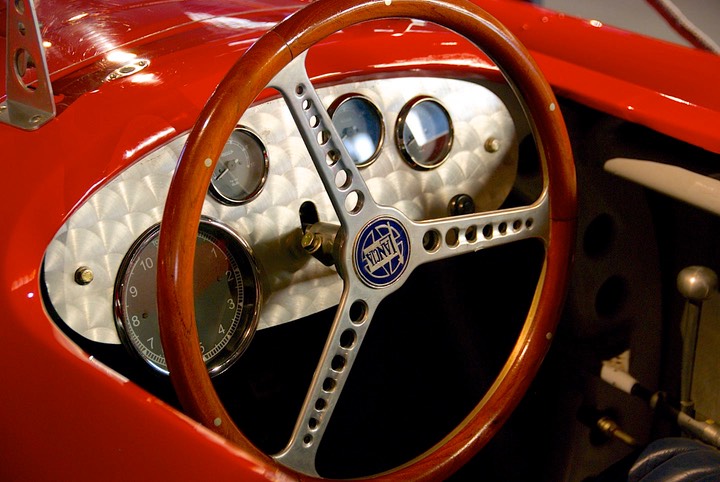
Balcarce was noisy, but that was no surprise. Every Argentine driver is a Fangio in the making. After Rick finished communing with the ghost of Fangio himself, we turned north and headed for Buenos Aires. By now we had finalized our exit plans for removing ourselves and our rig from South America. We had contracted with a ship that would be leaving from Zarate, a port upriver from Buenos Aires, about June 15. So we were heading in that direction to start to get organized.
By now the weather was changing. Our balmy fall days were over; it was colder and beginning to look like winter. It was almost the first of June; it looked like about the first of December. The skies were cloudy, although we saw no rain; the nights were distinctly chilly. The farmland is definitely in winter mode; the hay is in, the fields are either fallow or have corn stubble drying; huge piles of cordwood are stacked beside the farmhouses. We passed many small/tiny farming communities in the countryside south of Buenos Aires, and spent the night in one. We had pulled in kind of desperate for a quiet spot, and stopped because we’d seen a sign for the bomberos voluntarios (volunteer firemen); we knew we could either stay where they were housed or they could point us toward a good spot (which they did). There was almost nothing else in town. The area gave us the sense that this is what Argentine farmland has looked like for at least the last hundred years. A quiet night.
We were surprised at how much we were enjoying the area south and east of Buenos Aires. We had assumed that urban sprawl would cover the entire distance between Buenos Aires and Mar del Plata, the very major resort area south on the coast. But it was all rolling hills, cropland, and now very large cattle ranches, with trees every few miles. Apparently it was lambing season, as we saw lots of tiny babies, barely able to stand and sometimes still being licked by mama. Very pleasant.
The number of daylight hours is rapidly diminishing. On June 1 the sun came up just before 8:30, and it was dark by 6:00 or so. We may be moving north, but we are still 36 degrees south of the equator.
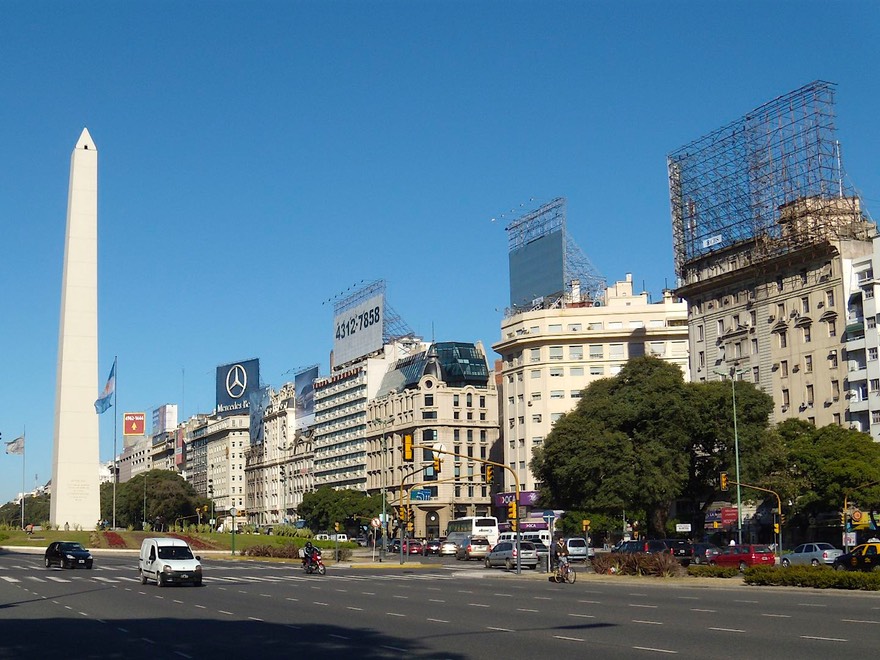
And suddenly we were in Buenos Aires. What a lovely city! A ferry terminal parking lot had been recommended as being both central to many of the sights, and secure overnight parking. We were driving in on a Sunday, which we thought might help, but there was still plenty of traffic and confusion, and we had some trouble getting from Point A to Point B, but finally we found our spot and settled in.
Over the next few days we checked in with our shipping company and finalized plans with them, poked around a bit, and also stopped in at the Buenos Aires clubhouse for the South American Explorers. We are very glad we are members. They allowed us to have our mail sent there (but that was the usual Argentina story…. post office wouldn’t deliver it; we would have to come pick it up, a several hour process). They also have an excellent book exchange and lots of advice on what to do/see/enjoy in Buenos Aires. Fun folks.
We had about a week of free time before we were going to need to drop off the truck at the dock, and we spent that time visiting Uruguay, which is right next to Argentina and easily accessed by ferry from right where we were parked.
Uruguay was a delightful surprise. It is, by the way, pronounced Oo-ru-wy. Or close to that. The country is often referred to as a “kinder and gentler Argentina.” Very similar but without any of the stress. People are polite and considerate, there are actually signs saying that pedestrians have the right of way, and the traffic signs are obeyed (the STOP sign really does mean stop). So right away we were very pleased.
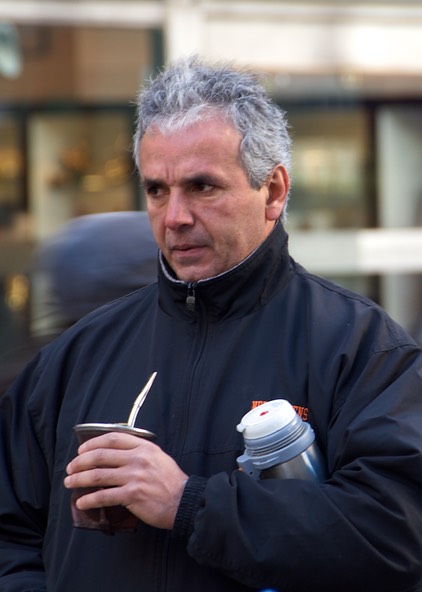
The folks we met were mellow to a fault. Uruguayans are famous for drinking maté all day long. Every other person we saw had a maté mug in hand and a thermos of hot water tucked into one elbow. The countryside is less dramatic than that which we had left in Argentina, but very pleasant. We liked every place we visited. Oh, and the country is known for having a huge percentage of old cars around; they come in all vintages and stages of usability. They were lots of fun, and made great picture subjects.
We took the Buquebus ferry across the Rió La Plata from Buenos Aires to Colonia, billed as a 3-hour trip; well, it took five before they actually got docked and unloaded. Couldn’t figure it out, but we watched them hand-turn the ferry around in this dinky harbor, and spend over half an hour wiggling it until they had it positioned correctly. Would never have made the cut in British Columbia, that’s for sure! We had seen a sign on board the ferry bearing the title of this missive: “Mantegna Siempre La Calma”, and now we knew why. But finally we were off-loaded, released by customs (there went my goodies again) and turned loose.
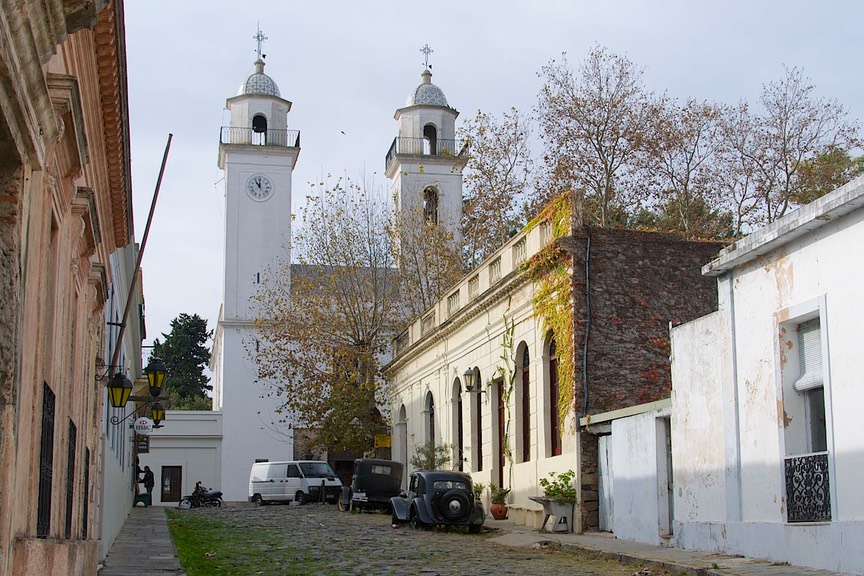
Colonia is a charming small city with cobblestone streets, neat churches, lots of the afore-mentioned funky old cars, very clean and cute. It’s now June, and wintertime; the trees are all barren of leaves; the streets are quiet and there are few tourists; in the summer it would be a busy place. There were tons of banners up advertising the various slates for the elections to be held on the 28th of the month. How could anyone actually remember all these people?
So, let’s talk about Uruguay, officially known as República Oriental del Uruguay. “Oriental” because that means east, i.e., the Republic East of the Uruguay (river). I hear you, much more than you want to know, but maybe it’s at least kind of interesting? The country only has one land border, with Brasil, on its northern edge. It is bordered on the south by the Rió La Plata, with Argentina on the other side. To the west is the Rió Uruguay and more Argentina (and Paraguay as well). In addition, Uruguay has a short coastline of its own. This coastline is most famously represented by Punta del Este, one of the world’s great summertime playgrounds, but basically closed down during the winter, the time of our visit.
Our general plan was to move east from Colonia to Montevideo (the capital), then on to the coast; we would move up the coast a ways towards the Brasilian border, then cut west across the middle of the country to the Argentine border, then back down to Buenos Aires.
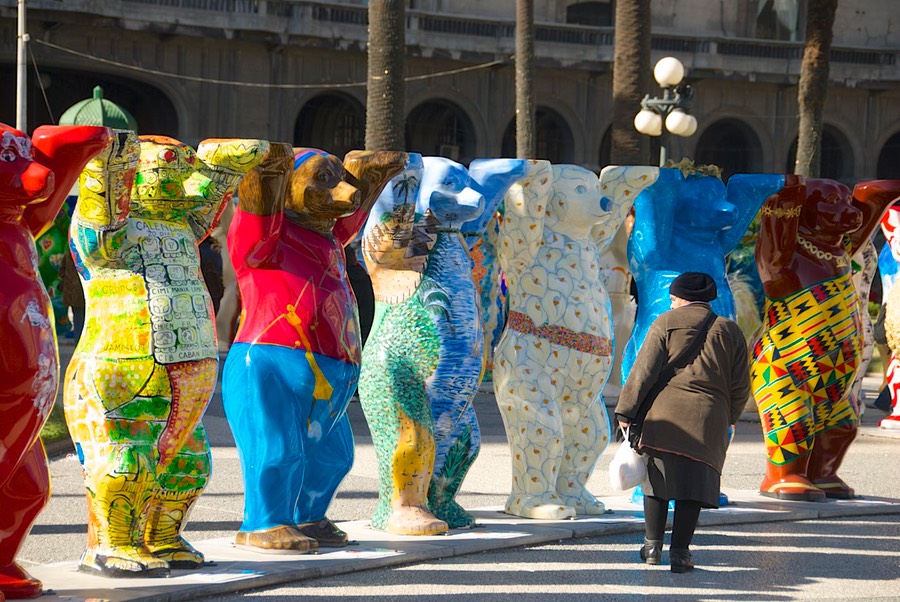
We spent a delightful day in Montevideo; this is one of the nicest capital cities in South America. It’s a good walking city, with big wide streets and plenty of parking. We had a lovely sunny day there and we walked our feet off.
There was an exhibit of bears in one of the main plazas; we spent a long time there, looking at each of them and absorbing their message. Got to tell you about the bears. There was one each from 140 different countries, painted by representative artists from each country. The project is called United Buddy Bears and it originated in Germany; each bear stands over 6 feet high, and they are stunning. They have been on tour since 2002, starting in Berlin, Germany, and have traveled to 5 different continents promoting greater world understanding. Do yourself a treat and take a look at the website that talks about them: www.buddy-bear.com. The exhibit was the highlight of our visit to Uruguay. (We have found out since that we were truly fortunate to be able to see the bears; this was their last stop before heading back to Germany, and Montevideo was a last-minute addition to an itinerary that was supposed to end in Buenos Aires.)
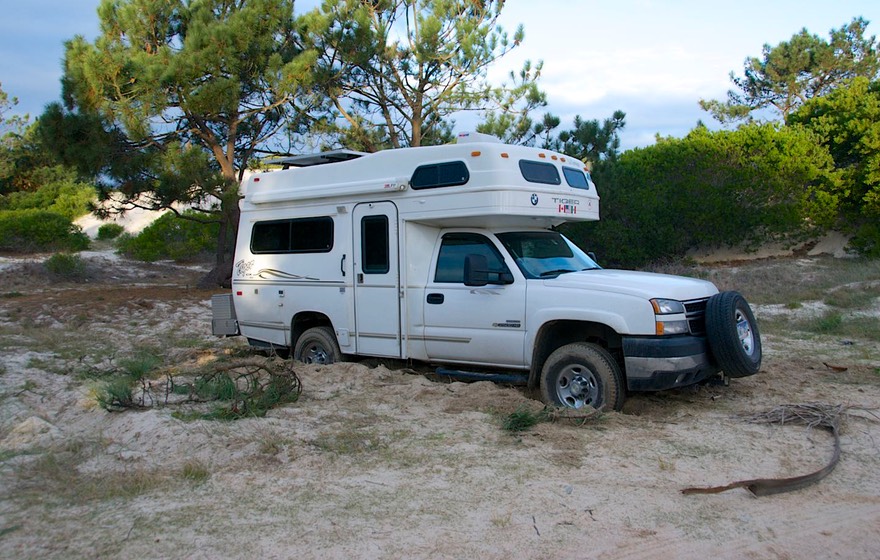
Finally tearing ourselves away from this cool city, we headed out to find a place to hang our hats for the night. Kathy wanted to spend the night in the dunes area east of Montevideo, so we got off the highway at El Pinar and went looking for a good spot. She urged Rick too far, though, looking to get away from folks, and we ended up getting stuck in the sand. This was to be our last GS (getting stuck) episode in South America. We had lots of different people come by, trying to help, some with maté in hand (and offering to share); lots of them dug for awhile before wandering on. A tow truck showed up but was unequal to the job. After an unsettled but quiet night, a German fellow and his son arrived mid-morning, dug for a bit, and then went off to get a guy they knew who had a backhoe. Well, his chain broke a couple of times, but we finally got everything pulling in the right direction and he had us out and on firm ground in two shakes. Another great adventure. These people were all lovely and happy to try and help us; no one was particularly concerned, as they knew it would all work out in the end. Mantegna siempre la calma!
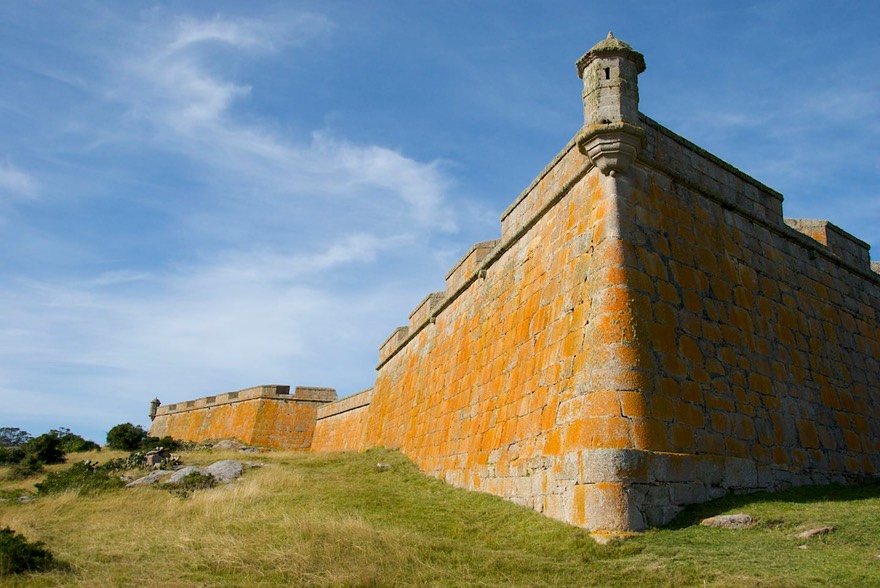
We wandered on, and checked out a cool fortress along the coast almost up to the Brasil border, in Santa Teresa NP. It was started by the Portuguese, then snatched by Spain. Poor Uruguay has had trouble finding its own identity through the centuries, having been fought over by both these other countries (to say nothing of Argentina’s designs); all this mostly because of the beef and leather trade, apparently.
Our road now took us inland. We lost the sunshine and gained some altitude (about 1500 feet at the highest). The land was rockier, and populated with lots of sheep and cattle. There was also lots of managed forest; it seemed to us that the entire country had probably been deforested, and the government was now trying to make a change (but this was just a surmise on our part). The temperature was cool (about 50 degrees), and ground fog was the rule for most of each day. Away from the more developed (and touristy) coast, the houses were mostly unpainted stucco and the towns were often just villages. Not much happening, but the folks seemed very friendly and content. We noticed it was mostly old people in the towns; the next generation was out working the fields.
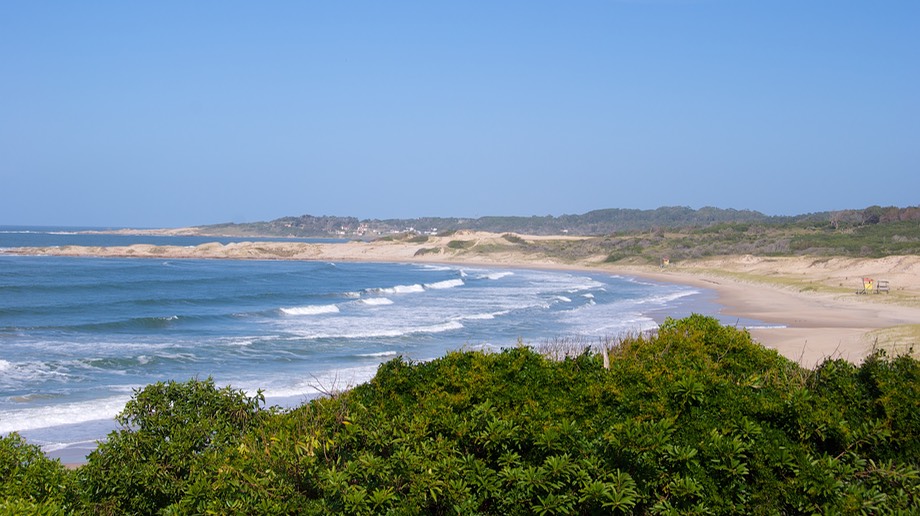
As we got back closer to Montevideo we saw some small vineyards; it was even colder now (in the low 40’s) and the ground fog got thicker. We were not able to really enjoy what might have been visible, but it still was a very pleasant experience. We saw many very large cemeteries, with huge mausoleums; they aren’t limited to Recoleta in Buenos Aires! They were quite astounding.
We had originally planned to cross back into Argentina along the western edge of Uruguay, and then travel down to the Rió La Plata and back into Buenos Aires. Suddenly we realized we were running out of time. We needed to start preparing La Tortuga for shipping back to the United States. So we ended up taking the Buquebus back across the river, back from whence we had come. That was great; we ended up in the same parking lot we had frequented before, and ran into some old überlander buddies, Armin and Marisol, who were also awaiting a shipping opportunity. We hugged and chatted and got caught up on the news.
We spent the next two days getting ready to ship, with all the throwing out of food, barricading points of entry, and everything else entailed in such a project, then delivered the Tiger to the port in Zarate, up river from Buenos Aires. Knowing that the port paperwork can be a huge hassle, we arrived the night before so that we could have a fresh start in the morning. “Fresh” wasn’t the half of it. We had planned to stay in a hotel in Zarate the night before delivery; couldn’t find one that had secure parking for the truck. So… we spent a last night in La Tortuga; a very cold night; it got down to 31 degrees outside (that’s -1 degree Celsius) – and 36 degrees inside the coach. We had no heat because our preparations to ship had piled large/heavy things in front of the furnace. The morning was indeed “fresh.” In typical fashion, the morning news shows were all making a fuss over the “unseasonably” cold snap.
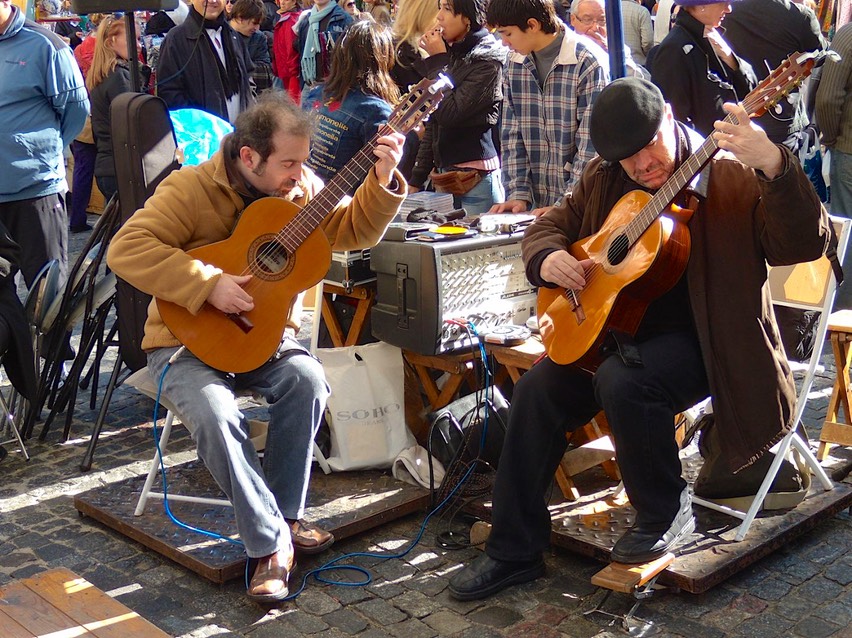
The dock paperwork turned out to be easy, and by noon we were back in Buenos Aires. We stayed in a hotel (the delightful Goya Hotel at www.goyahotel.com.ar) for the next 3 nights. We spent our days wandering around Buenos Aires, really enjoying ourselves. The weather was beautiful and clear, and had warmed (naturally), although the locals were shivering. We walked our feet off; poked around historic buildings, wandered the beautiful parks, and even saw a museum or two (including the Museo Eva Perón, which was fascinating); saw street tango artists; and generally enjoyed being in this vibrant and exciting city. On our last day in town our favorite French family showed up to join us for lunch, and then we took off for the airport.
While waiting for our evening flight, we thought about Argentina and South America, and our experiences here.
We had spent longer in Argentina than in any other single country, about 4 months all-told. It is huge, and has so many interesting places to visit. It also proved to be “less” than we had expected in many ways. Many travelers list Argentina as one of their favorite countries for its wide-open spaces and scenic beauty, so perhaps our expectations were too high. We were troubled by more incidents of corruption than we had experienced in other countries. It turned out to be a difficult country for travelers to receive mail or shipments of repair parts for their vehicles as customs regulations are unnecessarily difficult. We were stopped for the inspection of our papers far more often than in other countries; we made the decision to steer completely clear of one province, Entre Rios, because of its well earned reputation for corrupt police; this has gone on for years and is still current - our friend Casper sat in a police office for six hours because he refused to pay the requested bribe. We also experienced our most major theft in this country and were warned about the dangers of being accosted and robbed in major cities, including Mendoza and Buenos Aires itself. All of that said, we have many wonderful memories of Argentina and its people. For us, though, our favorite countries remain those along the Andes: Chile in the south, and Peru, Ecuador and Colombia in the north.
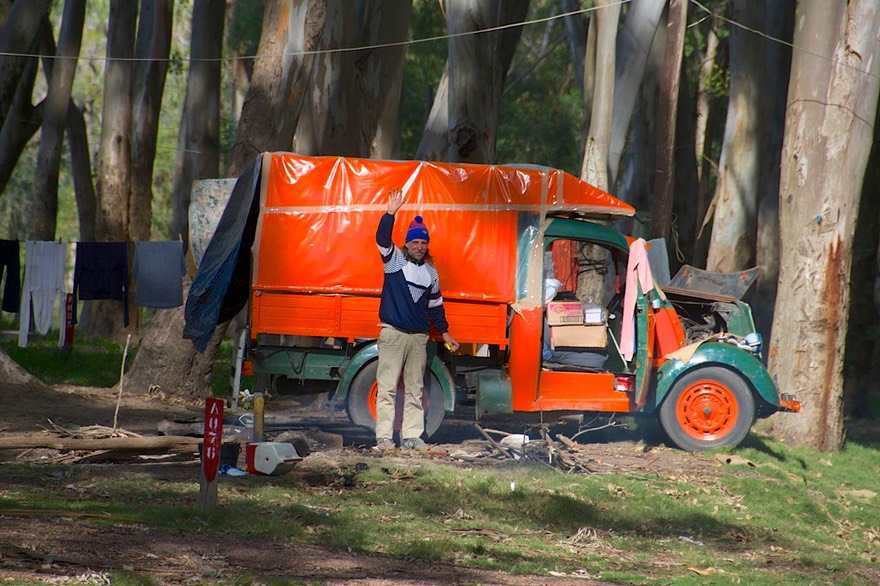
We are sorry to be leaving South America; overall it has been an incredible experience, one that will be difficult to duplicate. We were here for just over one full year, and still had to leave several areas undiscovered. We regret being unable to see Iguazú Falls or visit Brasil, both of which we had been looking forward to; and our one week in Uruguay did not begin to do justice to that lovely and peaceful country. Another regret is that our truck problems in far southern Chile prevented us from exploring that beautiful area as much as we would have liked. For reasons relating to political unrest we did not enter Bolivia or Venezuela at this time and would hope that conditions in those countries might improve in the future. Somewhat to our surprise, as we’ve always looked at this as kind of a once in a lifetime trip, we are now talking seriously about coming back to South America in a few years and picking up where we left off. Now where is that Portuguese dictionary?
South America has so many charms: being kissed on the cheek as a greeting (even by youngsters) in place of our cold north American handshake; the incredible beauty and gentle aura of the Andean cultures; the ease of getting very fresh fruits and vegetables; the charm of streets and towns named after people and important dates; fresh bread right around the corner; killer ice cream; and, of course, the use of kilometers: I love them because they go by so fast. There are nuisances, of course, as well: the crazy drivers and unsigned intersections; perfumed laundry detergent that stays on your clothes for days after you pick up the washing; the trash that permeates the roads in some countries; those nasty Aduana Iguanas. But these are all minor issues; we would (and will) go back as soon as we can.
* * * * * * * * * * * * * * *
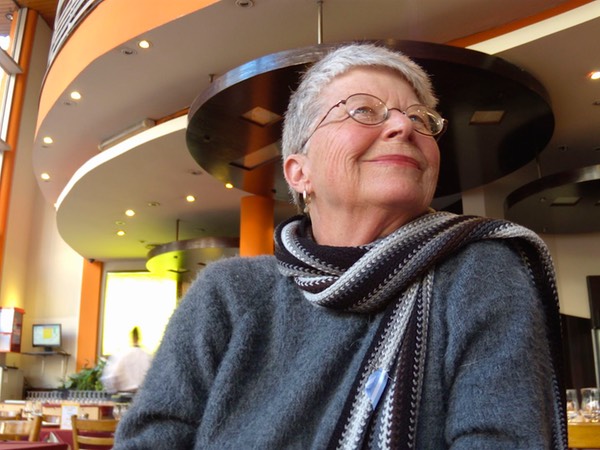
Our flights (from Buenos Aires to Mexico City and then on to the States) both left on time (yeah!), and having survived them, we arrived at noon the next day in Houston, Texas, to be greeted by a nice fellow with a deep East Texas drawl – culture shock in the extreme. Also, it was now mid-summer instead of mid-winter: 95 degrees and horribly humid. We went from the winter solstice to the summer solstice; from short days to ones where the sun was in our faces from 5:30 am to 9:30 pm. Welcome home, travelers!
La Tortuga will arrive in Jacksonville, Florida in mid-July. (Florida? In July? We really are out of our minds!) Our current plan is to remain in the United States until next spring. At that time we hope to once again venture forth out into the world as we ship ourselves and La Tortuga to Europe. Ever onward!
Rick and Kathy, sans Tortuga for a little while
Click the link to see more photos from Buenos Aires & Uruguay.